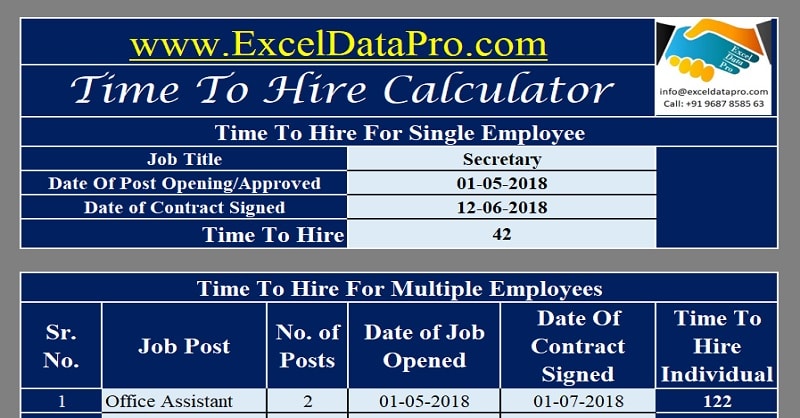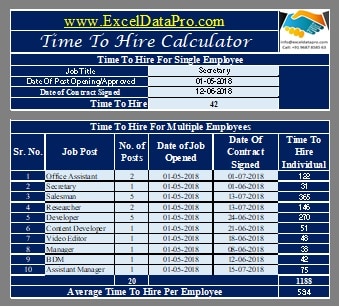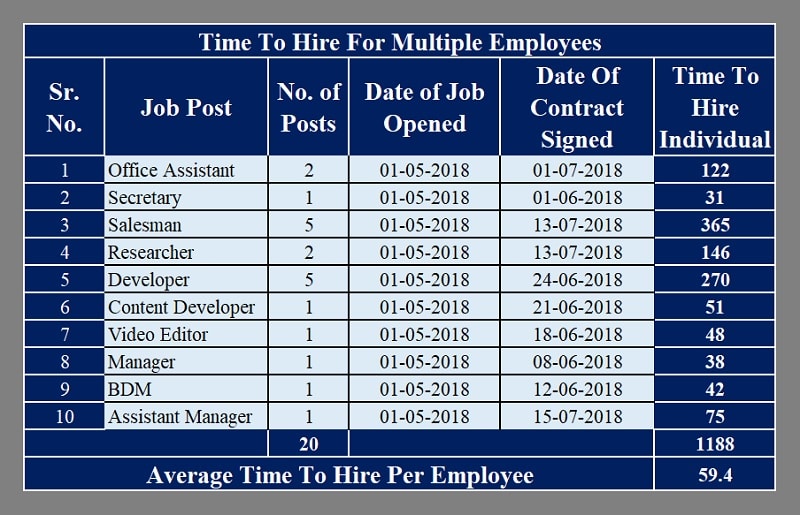
Use this Online Time To Hire Calculator to get the desired metric in just a few clicks or download a free template in Excel.
| Time To Hire Calculator | |
|---|---|
| Date of Candidate Joining | |
| Approval Date of Job Position | |
| Time To Hire : | Days |
Time To Hire Calculator is a simple and ready-to-use excel template to calculate Time To Hire HR metrics for a single as well as multiple employees.
What is Time To Hire (TTH)?
Time To Hire is the number of days between a position opening up and signing of a job contract by the candidate or accepting the offer.
It is used to evaluate the efficiency of the recruitment process and also provides insights into which job position takes more time to fill.

Formula To Calculate Time To Hire
The formula to calculate Time To Hire as follows:
Date Of Signing Contract – Date of the job position is opened/approved
If there are multiple job opening then it will be calculated in the following way:
- Calculate the number of days for each position.
- Add the number of days for all positions.
- Divide the total of days by the number of positions.
Click here to know more about Time To Hire.
Time To Hire Calculator Excel Template
We have created a simple and ready-to-use excel template with predefined formulas for Time To Hire HR Metric.

You just need to enter the dates and number of employees for the required position. It will automatically calculate the Time To Hire for a single as well as multiple employees.
Click here to download the TIme To Hire Calculator Excel Template.
Click here to Download All HR Metrics Excel Templates for ₹299.You can download other useful HR Metrics Templates like Time To Fill Calculator, Average Training Hours Calculator, Offer Decline Rate Calculator, Offer Acceptance Rate Calculator, and many more from our website.
Let us understand how to use this Calculator in detail.
How To Use Time To Hire Calculator Excel Template?
Time To Hire Calculator consists of 2 sections:
- Time To Hire For Single Employee
- Time To Hire for Multiple Employees
1. Time To Hire For Single Employee
As given above, time to hire is nothing but the difference between the date of an opened job posting and the date of contract signing by the candidate.

In this section, you just need to enter 3 things:
- Job Title
- The date on Which the job posting opened up or approved by the management
- The date on which the employee accepted your offer or signed the contract.
That’s it. Applying the given above given formula it will calculate the Time To Hire for that particular post for you.
2. Time To Hire for Multiple Employees
When there are multiple job openings in a company like a new start-up or the opening of a new department etc, then this section can be used.
There are 6 columns in this section:
Sr. No.: Job Posting Serial Numbers.
Job Post: The title of the job posting.
No. of Posts: The number of posts for each job posting.
Date of Job Opened: Date on which the job posting opened or approved by the management.
Date of Contract Signed: Date on which the candidate signs the job contract/accepts the job offer.
Time To Hire Individual: This is TTh for an individual post. If there are multiple posts in a single job posting then it will multiply it with that number.
For example; if there are 2 posts for an Office Assistant as shown in the figure below, then it will multiply the number of days obtained by the difference of dates with 2.

In the end, the calculations of Average Time To Hire Per Employee is given. The formula applied here is:
Total Number of Day / No. of Employees
This calculator will be helpful to HR Assistants, HR manager as well as HR professionals.
5 Important Things To Do To Reduce Time To Hire
- Determine staffing needs
- Try to reduce notice periods
- Recruit internally
- Write a detailed job description including benefits
- Use application tracking Software or Templates
We thank our readers for liking, sharing, and following us on different social media platforms.
If you have any queries or suggestions please share in the comment section below. I will be more than happy to assist you.
Powerful I enjoyed it
Thank you very much
God bless you
Thanks, dear. Happy to know you liked it. May God Bless you too and please share it with your friends and colleagues.